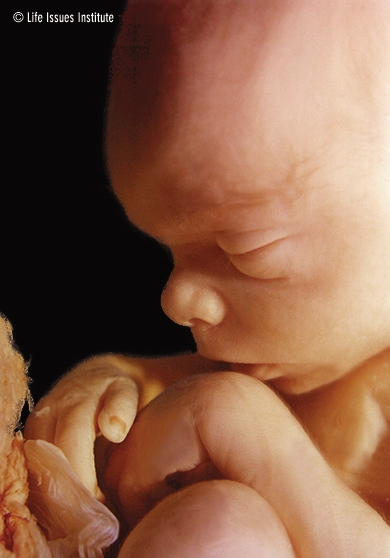 It’s time for the facts to be known…
It’s time for the facts to be known…
Myth: Abortion is basically a private matter.
Fact: Not really. Abortion involves more than a woman and her doctor. Even more directly and intimately involved is a third human being: the mother’s unborn child; the doctor’s unborn patient. And the father? Presently, he has no say in the fate of his offspring.
Abortion has broad consequences for the whole of society. How can one pretend that the very acceptance of the large scale killing of innocent, defenceless, unborn human beings through abortion does not foster the creation of a psychological climate favourable to the development of other forms of violence which are becoming a characteristic trait of our times (child abuse, infanticide and physician-assisted death)? More than 100,000 abortions are performed in Canada every year.
Myth: Every woman should have the right to control her own body.
Fact: Yes, but only her own body, not that of her child who, while developing inside her body, is completely distinct from it, the only organic link between the two being the umbilical cord. Any remaining doubts about the separate identities of the pregnant woman and her child have been put to rest with the advent of in-vitro fertilization procedures, in which the earliest stages of the new life take place outside the mother’s body and by the use of amniocentesis, a procedure which tests for possible anomalies of the developing baby – not of the mother.
Williams Obstetrics, 16th. Edition 1980, a standard obstetrics textbook in medical schools throughout North America, states: “Happily, we have entered an era in which the fetus can be rightfully considered and treated as our second patient…Who would have dreamed, even a few years ago, that we could serve the fetus as physician?”
Any person’s rights are limited by the rights of others. A woman’s proclaimed right to control her own body does not include a “right” to have her unborn child killed by abortion. Her child has just as much right to life as any other human being.
There are no circumstances, other than abortion, in which a person is allowed to kill an innocent, defenceless human being. The exception accorded the act of abortion is unwarranted and totally illogical. Abortion cures no disease. Pregnancy is not a disease.
Myth: Abortions are performed to preserve the physical health of the mother.
Fact: The late Dr. Henry Morgentaler, an abortionist, wrote years ago that “medicine has over the last few years made so much progress that it is now possible for a very sick woman to complete a pregnancy and give birth in spite of serious illness”.
Except in rare instances, such as ectopic pregnancies, in which the child cannot survive, the medical evidence suggests that having an abortion is more dangerous than the continuation of the pregnancy. The procedure performed to remove the fallopian tube in case of ectopic pregnancy is not an abortion.
Myth: Abortions are performed to preserve the mental health of the mother.
Fact: There are no studies to substantiate this claim. On the contrary, abortion is a well documented stressful event and it has been shown that abortion can be followed by serious psychological disorders including depression, anxiety, lack of self esteem, substance abuse and suicide. One meta-analysis of published research on abortion and mental health from 1995-2009 found that “overall, the results revealed that women who had undergone an abortion experienced an 81{a886d2509afb02fdbd678c9c9cbef29e9b4ac8f1454580a0bf53ee67e764b753} increased risk of mental health problems, and nearly 10{a886d2509afb02fdbd678c9c9cbef29e9b4ac8f1454580a0bf53ee67e764b753} of the incidence of mental health problems was shown to be directly attributable to abortion.” (1)
A 2008 study found that “abortion was associated with a small increase in the risk of mental disorders; women who had had abortions had rates of mental disorder that were about 30{a886d2509afb02fdbd678c9c9cbef29e9b4ac8f1454580a0bf53ee67e764b753} higher.” (2)
Myth: Abortions help prevent suicides.
Fact: The stress of undergoing an abortion has been associated with an increased risk of suicide. Conversely, no evidence exists that continuing with an unplanned pregnancy will endanger the mother’s mental health.
-
A study on suicides after pregnancy in Finland revealed that “Suicides are more common after a miscarriage and especially after an induced abortion than in the general population. Increased risk for suicide after an abortion indicates either common risk factors for both or harmful effects of induced abortion on mental health.” (3)
- The deVeber Institute for Bioethics and Social Research reports that “Four large scale studies from Scandinavia, the US and Britain have documented a sharply higher rate of suicide among women who have had abortions compared to women who have completed their pregnancies.” (4)
Myth: Legal abortions are safe abortions.
Fact: The fact that a licensed physician performs the abortion does not guarantee safety: no abortion is without very real and serious risks to both the physical and emotional health of the woman.
There are a number of possible complications listed in the Canadian Institute for Health Information’s document on Induced Abortions reported in Canada in 2019, including haemorrhage, infection, retained products of conception, combination (more than one complication) and “other.” Complications not listed in the document include uterine perforation and cervical laceration.
The long term physical problems of induced abortion include infertility, sterility and cervical incompetence which often leads to premature labour and delivery, along with an increased risk for immature babies during subsequent pregnancies. The Royal College of Obstetricians and Gynecologists in its guidelines for abortion acknowledged : “Genital tract infection, including pelvic inflammatory disease, is a recognised complication of abortion. Post-abortion infection may later result in tubal infertility or ectopic pregnancy as well as causing morbidity in the immediate post-abortion period.” (7)
Scientific research has established that abortion is an independent risk factor for the development of breast cancer. Overall, there is a 50{a886d2509afb02fdbd678c9c9cbef29e9b4ac8f1454580a0bf53ee67e764b753} increased risk of developing breast cancer if the first pregnancy is not brought to full term. For the woman who has undergone one abortion during her reproductive years, there is a 30{a886d2509afb02fdbd678c9c9cbef29e9b4ac8f1454580a0bf53ee67e764b753} increased risk of developing breast cancer in her life time. Repeat abortions increase the risk factor. Unfortunately, there has been a medically indefensible conspiracy of silence about the health risks attending legal abortions.
Myth: Abortion is legal: so it cannot be all that bad.
Fact: Legality cannot change reality and the reality is that “[T]he induction or procuring of abortion involves the destruction of life. It is a violation both of the moral law and the Criminal Code of Canada, except where there is justification for its performance. The only justification is that the continuance of pregnancy would imperil the life of the mother.” (Code of Ethics – the Canadian Medical Association (1963)).
Even though the CMA has since changed its views on abortion and in spite of the 1988 Supreme Court ruling which has removed abortion from the realm of criminal law, abortion remains what it has always been: the deliberate killing of an unborn human being.
If child abuse were made legal tomorrow, would it be right?
Myth: Anyway, the fetus is not really a person.
Fact: Words such as ’embryo’ or ‘fetus’ serve the same purpose as calling human beings ‘infants,’ ‘children,’ ‘adolescents’ or ‘adults’ at other stages of their lives. They are simply scientific terms used to indicate where a person is in his or her development: in no way do they mean that the unborn child is not human.
The advocates of abortion claim that the unborn child is a mere clump of cells. But the scientific facts are that a living, unmistakably human organism exists from the moment the ovum is fertilized; it will not develop into a cat or a plant – only a human being, because it is already a human being.
Just 9 weeks after conception all internal organs of the unborn child are present, including functioning heart, kidneys and liver; the nervous system and brain are also functioning and the child reacts to touch or painful stimuli. Furthermore, the unborn child while still in the womb can now be viewed by ultrasound and many of its functions can be monitored by various sophisticated techniques. He or she can receive blood transfusions and medications and even be treated surgically. Abortion brings that young life to an end.
An editorial in the September 1970 issue of California Medicine, the official publication of the California Medical Association, mentions, “the scientific fact, which everyone really knows, that human life begins at conception and is continuous, whether intra- or extra-uterine, until death.” In the Van Nostrand’s Scientific Encyclopedia, Fifth Edition, one can read, “from a purely scientific standpoint, there is no question but that abortion represents the cessation of human life.”
It is a sad reflection on our times that precisely when scientific and technological advances provide us with the means to keep unborn children alive at earlier and earlier stages of pregnancy, more and more of these children are being killed by abortion.
Myth: Abortion helps to prevent child abuse.
Fact: Abortion is not a cure for child abuse. Most children battered by their parents were ‘wanted’ and resulted from planned pregnancies. Studies have shown that child abuse has risen with the legalization of abortion. In 1997, with abortion widely available, the statistics showed an escalating number of child abuse cases reported across Canada including intimidation, neglect, beatings, burnings, sexual interference and killings.
A 2007 study found that:
“Abortion history was associated with more frequently maternal slapping, hitting, kicking or biting, beating, and use of physical punishment in general.”(5)
A 1993 study by Dr. Phillip Ney and colleagues stated :
Canadian provinces that have high rates of abortion also have high rates of child abuse. The rates have increased parallel with each other. In British Columbia the rates of deaths of children and adolescents from social causes seem to have increased shortly after the change in legislation liberalizing abortion. Although this association may be due to common causes such as socio-economic conditions or societal attitutes towards children, it is clear that there is no evidence that thre has been a diminution in the rate of abuse. (6)
Myth: Every child a wanted child.
Fact: This slogan is not as loving as it sounds, since it reduces children to objects with a right to exist only if someone ‘wants’ them more than they desire other ‘things’. It also fails to take into account the fact that the feelings of a woman toward her pregnancy during the early months often differ markedly from what they will be at later stages of her pregnancy or after the birth of her child.
On the other hand, while there may be parents who do not want children, there really are no unwanted children: witness the countless and often desperate couples who have to wait years before they are able to adopt a child. Human life has an intrinsic value which has nothing to do with the fact that this tiny human being may or may not be wanted. The idea that the ‘undesirables’ can be eliminated is a most dangerous concept. Once we accept the ethic that every child must be ‘wanted’ before it can live, our society may also decide that every grandparent and every mentally or physically handicapped person should also be ‘wanted’ in order that they may be permitted to continue living.
Myth: Abortions cannot be immoral since they are performed by doctors.
Fact: Medical ethics since the time of Hippocrates have upheld the traditional role of doctors as the preservers of human life. The Hippocratic Oath clearly states: “I will give no deadly medicine to anyone, if asked, nor suggest any such counsel; furthermore, I will not give to a woman an instrument to produce an abortion.” The Declaration of Geneva, a modernized version of the Hippocratic Oath adopted by the World Medical Association in 1948, specifically states, “I will maintain the utmost respect for human life, from the time of conception.”
A growing number of doctors feel it is their duty to speak against this “new ethic” of killing unborn children upon request and as a result, also possibly causing serious harm to their mothers.
(1) Coleman PK. Abortion and mental health; quantitative synthesis and analysis of research published 1995-2009. British Journal of Psychiatry 2011; 199(3): pp. 180-6; 200(1): pp. 77-80. (2) Fergusson DM, Horwood LJ, Boden JM. Abortion and mental health disorders: evidence from a 30 year logitudinal study. British Journal of Psychiatry 2008; 193: pp.444-51. (3)Gissler M, Hemminki E, Lonnqvist J. Suicides after pregnancy in Finland, 1987-94: register linkage study. British Medical Journal 1996 December; 313 (7070): pp. 1431-4. (4) The deveber Institute for Bioethics and Social Research. Complications: Abortion’s impact on women. 2nd edition, revised and updated. 2018, p.261. (5) Coleman, PK, Rue VM, Coyle CT, Maxey CD. Induced abortion and child-directed agression among mothers of maltreated children, Internet Journal of Pediatrics and Neonatology 2007; 6(2). (6) Ney PG, Fung T, Wickett AR. Relationship between induced abortion and child abuse and neglect: Four sutudies. Pre-andPeri-natal Pscychology Journal 1993 October; 8 (1): 43-63, p.44. (7) Royal College of Obstetricians and Gynaecologists. The care of women requesting induced abortion. Evidence-Based Clinical Guideline7, 2011:p.42. This information was adapted in November 2021 from the text, WE SAY NO TO ABORTION prepared and published in 1988 by Ottawa and District Physicians for Life.Action Life Online Article


